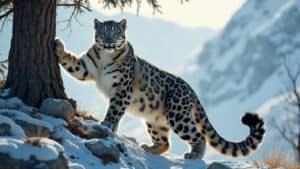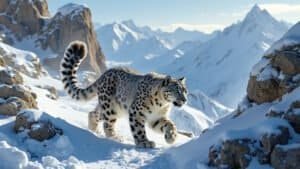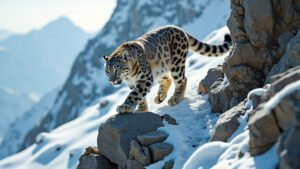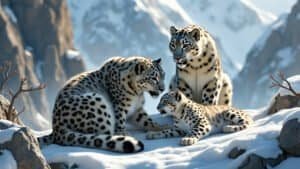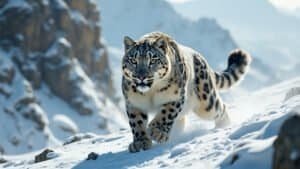Introduction
Snow leopards, known for their elusive nature and majestic presence, have developed a variety of hunting techniques to thrive in their rugged, mountainous habitats. This article explores these primary hunting methods, including their stalking and ambushing strategies, the use of camouflage, and the adaptations that enable their success
We will delve into the specifics of how snow leopards utilize the challenging terrain, their stealthy approaches to hunting, and the critical role of their physical and behavioral adaptations. By understanding these techniques, we gain insight into the fascinating and often perilous lives of these magnificent predators
Stalking Techniques
Snow leopards, known for their stealth and precision, rely heavily on their stalking techniques to hunt successfully. These big cats are solitary hunters, and their approach to stalking prey is a critical component of their survival in the wild
Understanding their methods provides insight into the intricate balance of predator and prey in the mountainous regions they inhabit
Methods of Stalking Prey
Snow leopards begin their hunt by locating potential prey from a distance. They have excellent vision, allowing them to spot prey even in the vast and rugged terrain of their habitat
Once a target is identified, the snow leopard moves quietly and slowly, using the terrain to its advantage. The rocky outcrops and sparse vegetation provide natural cover, allowing the leopard to get as close as possible without being detected
The initial phase of stalking involves careful observation and planning. Snow leopards often follow the movements of their prey, waiting for the perfect moment to approach. This phase can last several hours as the predator patiently waits for the right opportunity
The goal is to get within striking distance, typically around 20-50 feet, where a quick burst of speed can close the gap
Role of Stealth and Silence
Stealth is crucial for snow leopards during the stalking process. They move with incredible caution, placing their paws carefully to avoid making noise
Their padded feet help reduce sound, and their fur color provides effective camouflage against the rocky and snowy background. Any sudden movement or noise could alert the prey, resulting in a missed opportunity and wasted energy
Snow leopards also take advantage of their environment by stalking downwind of their prey to prevent their scent from being detected. This requires a keen sense of wind direction and environmental awareness. The ability to remain undetected until the final moments of the hunt is a testament to the snow leopard’s exceptional hunting skills
Examples of Successful Stalking
Numerous documented instances showcase the effectiveness of snow leopard stalking techniques. For example, in the Himalayas, researchers observed a snow leopard stalking a group of blue sheep
The leopard used the rocky terrain to stay hidden, moving only when the sheep were distracted. After several hours of patient stalking, the leopard managed to get within striking distance and successfully pounced on an unsuspecting sheep
Another example involves a snow leopard in the Altai Mountains, which stalked an ibex along a narrow mountain ledge. The leopard’s ability to navigate the precarious terrain without alerting the ibex demonstrated its remarkable agility and stealth. The successful hunt was the result of careful planning, silent movement, and the strategic use of the landscape
These examples highlight the critical importance of stalking in the snow leopard’s hunting strategy. The combination of keen senses, patient observation, and silent movement allows these predators to thrive in some of the harshest environments on Earth
Stalking in Different Seasons
Snow leopards adapt their stalking techniques to the changing seasons. During winter, their white-gray fur blends seamlessly with the snowy environment, providing additional camouflage
The cold weather also makes prey more vulnerable, as animals like blue sheep and ibex descend to lower altitudes where food is more accessible, making them easier targets for snow leopards
In summer, the landscape changes, and the snow leopards must rely more on the rocky terrain and sparse vegetation for cover. Their ability to adapt their stalking methods to the seasonal variations in their habitat demonstrates their versatility as hunters
Challenges in Stalking
Despite their prowess, snow leopards face significant challenges while stalking prey. The rugged terrain, while providing cover, can also hinder movement
Prey animals are often well-adapted to their environment and have keen senses to detect predators. Additionally, the solitary nature of snow leopards means they cannot rely on group tactics like some other big cats
The success rate of snow leopard hunts is estimated to be around 20-30%, indicating that while they are skilled hunters, they often face failures. This low success rate highlights the difficulty of their lifestyle and the need for efficient and effective hunting techniques
Snow leopards’ stalking methods are a blend of patience, stealth, and strategic use of their environment. Their ability to silently approach and capture prey in the challenging mountainous regions showcases their remarkable adaptations and survival skills
By understanding these techniques, we gain a deeper appreciation of the snow leopard’s role in the ecosystem and the delicate balance of nature in their high-altitude habitats
Utilizing Mountainous Terrain
Snow leopards inhabit some of the world’s most challenging and rugged terrains. Their survival and hunting success are largely attributed to their ability to navigate and utilize these mountainous regions effectively
This section explores how snow leopards leverage the high altitudes and rocky landscapes to their advantage during hunts
Advantages of High Altitudes
Snow leopards are found in the high mountain ranges of Central and South Asia, including the Himalayas, the Karakoram, and the Altai Mountains. These altitudes, ranging from 9,800 to 17,000 feet, provide several advantages for these elusive predators
The thin air and harsh climate limit the number of competing predators, giving snow leopards a more exclusive hunting ground
The altitude also affects the behavior of prey animals. Species like blue sheep and ibex, which are primary prey for snow leopards, are adapted to these high altitudes and rely on the same rugged terrain for survival
The snow leopard’s ability to thrive in such environments gives it an edge, as it can pursue these prey animals into areas that other predators cannot reach
Navigating Rocky Landscapes
Snow leopards possess remarkable agility and strength, which allow them to traverse the steep, rocky landscapes with ease
Their powerful hind legs enable them to leap distances of up to 50 feet, crucial for navigating the gaps between rocks and cliffs. This agility is essential for both stalking prey and making quick escapes from potential threats
The rocky terrain offers numerous hiding spots and vantage points. Snow leopards often use elevated positions to survey their surroundings and spot potential prey from a distance. Once they have identified a target, they can use the terrain to conceal their approach, moving from rock to rock and using the natural cover to get closer without being seen
Impact of Terrain on Hunting Success
The mountainous terrain plays a significant role in the hunting strategies and success rates of snow leopards
The uneven ground and numerous obstacles provide natural barriers that can trap or slow down prey, making it easier for the snow leopard to close in for the kill. The element of surprise is enhanced in such environments, as prey animals have limited visibility and fewer escape routes
Studies have shown that snow leopards often choose hunting grounds with specific topographical features that favor their hunting style. For example, steep slopes and narrow passes are preferred because they channel prey into predictable paths, making ambushes more effective. The ability to understand and exploit these features demonstrates the snow leopard’s intelligence and adaptability
Challenges of the Terrain
While the mountainous terrain offers many advantages, it also presents challenges. The same rocky landscapes that provide cover and vantage points can be treacherous, requiring careful navigation. A misstep could result in injury or alerting prey, leading to a failed hunt
The thin air at high altitudes also means that snow leopards must exert more energy to move and hunt, increasing their caloric needs. This makes successful hunts even more critical, as a single failed attempt can have significant consequences for their energy reserves and overall survival
Moreover, the harsh climate and unpredictable weather can impact hunting activities. Snow leopards must be resilient and adaptable to deal with sudden changes in weather, which can affect both their mobility and the behavior of their prey
Terrain Adaptations
Snow leopards have evolved several physical adaptations to help them thrive in mountainous terrain. Their thick fur provides insulation against the cold, while their large nasal cavities warm the cold air before it reaches their lungs
Additionally, their long, thick tails help with balance on narrow and unstable surfaces, and can be wrapped around their bodies for extra warmth when resting
Their strong, muscular build and short forelimbs with well-developed chest muscles enable them to climb steep slopes and chase prey over rocky ground. These adaptations are crucial for their survival and efficiency as hunters in such a demanding environment
Camouflage and Concealment
Snow leopards are masters of camouflage and concealment, crucial skills for hunting in their rugged, mountainous habitats. Their ability to blend seamlessly into the environment allows them to approach prey undetected and enhances their overall hunting success
This section delves into the natural camouflage of snow leopards, their techniques for blending in, and the importance of these skills in their hunting strategy
Natural Camouflage of Snow Leopards
Snow leopards have a thick, pale gray fur with dark rosettes and spots that provide exceptional camouflage against the rocky and snowy landscapes of their habitat
This coloration allows them to blend into their surroundings, making them nearly invisible to both prey and potential threats. The fur’s pattern mimics the shadows and textures of the mountains, breaking up the outline of their bodies and helping them stay concealed
The fur changes slightly with the seasons, becoming thicker and whiter in winter to match the snow-covered terrain, and shedding to a lighter, more grayish tone in summer when the snow melts, revealing more of the rocky ground. This seasonal variation in fur color enhances their camouflage throughout the year
Techniques for Blending In
Snow leopards employ various techniques to maximize their camouflage and remain hidden while hunting. One of the primary methods is their careful selection of resting and stalking spots. They often choose locations with ample cover, such as rocky outcrops, cliffs, and dense vegetation, which help them stay out of sight while observing their surroundings
When stalking prey, snow leopards move slowly and deliberately, using the natural cover of rocks and vegetation to approach their target
They crouch low to the ground, minimizing their profile and reducing the chances of being spotted. Their large paws allow them to move quietly, even on snowy or rocky surfaces, further aiding their stealth
In addition to physical concealment, snow leopards also use behavioral tactics to remain undetected. They often hunt during dawn and dusk, times when the low light levels make it harder for prey to see them. This crepuscular activity pattern aligns with the times when prey animals are most active, increasing the chances of a successful hunt
Importance of Camouflage in Hunting
Camouflage is vital for snow leopards, as it directly impacts their ability to catch prey
The element of surprise is crucial for these solitary hunters, who rely on getting as close as possible to their target before launching an attack. Without effective camouflage, prey animals would spot them from a distance and escape, leading to failed hunts and wasted energy
The mountainous terrain, while providing natural cover, also poses visibility challenges due to its open and exposed nature. Effective camouflage helps snow leopards remain hidden in these environments, allowing them to ambush prey from a close range
This strategy is especially important given their low hunting success rate; any advantage in staying concealed can significantly improve their chances of making a kill
Examples of Camouflage Success
Numerous observations and studies have documented the effectiveness of snow leopard camouflage in the wild
In the Himalayas, for instance, researchers have noted how snow leopards can disappear into the rocky landscape, even when they are in plain sight. Their ability to blend in so well often makes it difficult for even experienced trackers to spot them
A notable example involves a snow leopard that was observed by a team of wildlife photographers in the Ladakh region of India. The leopard was resting on a rocky ledge, perfectly camouflaged against the surrounding rocks
Despite being only a few meters away, the photographers initially failed to notice the leopard until it moved. This incident highlights the exceptional camouflage abilities of snow leopards and their reliance on this skill for survival
Adaptive Camouflage Strategies
Snow leopards also demonstrate adaptive strategies in response to different environments within their range
In areas with more vegetation, they may use trees and bushes for cover, while in more open rocky areas, they rely on the shadows and textures of the rocks. This adaptability ensures they can remain concealed in various habitats and increases their hunting success
Moreover, snow leopards teach their cubs the importance of camouflage and stealth from a young age. Cubs learn to stay hidden and move quietly by observing their mothers, honing these critical skills that will be essential for their survival as adults
Ambushing Prey
Snow leopards are skilled ambush predators, relying on their stealth and the element of surprise to catch prey. Ambushing allows them to conserve energy and increase their chances of a successful hunt in the harsh environments they inhabit
This section explores how snow leopards set up ambushes, the timing and precision involved, and examples of their ambush tactics
Setting Up an Ambush
Ambushing requires careful planning and strategic positioning. Snow leopards typically choose ambush sites where prey is likely to pass, such as narrow mountain trails, ridgelines, or water sources
These locations offer limited escape routes for prey, increasing the chances of a successful attack
Snow leopards use their knowledge of the terrain to their advantage, often positioning themselves above their target. This elevated position not only provides a better vantage point to spot approaching prey but also allows the snow leopard to use gravity to increase the force of their pounce
The initial phase of setting up an ambush involves selecting a suitable hiding spot and remaining motionless while waiting for prey to come within striking distance
Timing and Precision in Ambushing
Timing is crucial in ambushing. Snow leopards must judge the right moment to attack, balancing the need to remain hidden with the necessity of getting close enough to ensure a successful strike. They often wait for prey to be distracted or to come particularly close before making their move
The precision of the ambush is equally important. Snow leopards rely on their powerful hind legs to launch themselves at prey with incredible speed and force. Their long, muscular tails help them maintain balance during the leap, ensuring a direct and powerful hit
The goal is to knock the prey off balance or pin it down immediately to prevent escape
The attack is usually swift and decisive. Snow leopards aim for the neck or throat to quickly subdue their prey, minimizing the risk of injury and conserving energy. This precise targeting is a testament to their hunting skills and physical prowess
Examples of Ambush Hunts
Numerous field observations and studies have documented successful ambush hunts by snow leopards. In the Tost Mountains of Mongolia, researchers observed a snow leopard ambushing a herd of argali sheep
The leopard positioned itself on a ledge overlooking a narrow path that the sheep regularly used. When the sheep passed below, the snow leopard launched itself from the ledge, catching an argali sheep by surprise and securing a successful kill
Another example involves a snow leopard in the Indian Himalayas, which ambushed a group of bharal (blue sheep) near a water source. The leopard waited patiently behind a large boulder, using the natural cover to remain hidden. As the bharal approached to drink, the snow leopard sprang into action, capturing a young sheep with a swift and powerful leap
These examples illustrate the effectiveness of ambushing as a hunting strategy for snow leopards. By choosing strategic locations and waiting for the right moment, they can catch prey off guard and maximize their chances of a successful hunt
Adapting Ambush Strategies
Snow leopards adapt their ambush strategies to different environments and prey. In areas with dense vegetation, they may use bushes and trees for cover, while in more open rocky areas, they rely on the terrain’s natural features to stay hidden
This adaptability ensures they can successfully ambush a variety of prey species in different habitats
During winter, when prey animals are more likely to congregate in lower altitudes due to harsh weather conditions, snow leopards adjust their ambush sites accordingly. They may take advantage of snowdrifts and other seasonal features to conceal themselves and increase their chances of a successful ambush
Challenges in Ambushing
Despite their skill, snow leopards face challenges while ambushing prey. The mountainous terrain, while offering excellent vantage points, can also make it difficult to approach prey without being detected
Prey animals in these regions are highly alert and have adapted to avoid predators, making successful ambushes challenging
Additionally, the solitary nature of snow leopards means they cannot rely on group tactics like some other big cats. Each hunt is a solo endeavor, requiring the snow leopard to perfect its ambush techniques through individual experience and learning
Hunting Adaptations
Snow leopards possess several physical and behavioral adaptations that enable them to hunt effectively in their harsh, mountainous environments
These adaptations are essential for their survival and success as apex predators in some of the most challenging terrains on Earth. This section explores the various hunting adaptations of snow leopards, including their physical characteristics, behavioral traits, and specific adaptations to snowy environments
Physical Adaptations for Hunting
Snow leopards have evolved several physical traits that enhance their hunting capabilities:
Powerful Build: Snow leopards have a robust and muscular build, particularly in their hind legs, which allows them to make powerful leaps of up to 50 feet. This strength is crucial for ambushing prey and navigating the steep, rocky terrain of their habitat
Thick Fur: Their thick, dense fur provides insulation against the cold temperatures of high-altitude environments. The fur also has a pattern of rosettes and spots that offer excellent camouflage against the rocky and snowy backgrounds, helping them stay hidden from both prey and potential threats
Large Paws: Snow leopards have large, wide paws that act like natural snowshoes, distributing their weight more evenly when walking on snow. This adaptation prevents them from sinking into the snow and allows for more efficient movement in snowy conditions
Long Tail: Their long, thick tail aids in balance and agility, helping them navigate the rugged terrain and maintain stability during high-speed chases and leaps. The tail can also be wrapped around their body for additional warmth when resting
Keen Senses: Snow leopards have excellent eyesight, allowing them to spot prey from great distances. Their sharp hearing also helps them detect the slightest sounds of potential prey or threats in their environment
Behavioral Adaptations
In addition to their physical traits, snow leopards exhibit several behavioral adaptations that enhance their hunting success:
Solitary Hunting: Snow leopards are solitary hunters, which allows them to cover large territories and reduce competition for food. They rely on stealth and surprise rather than cooperative hunting tactics
Nocturnal and Crepuscular Activity: Snow leopards are primarily nocturnal and crepuscular, hunting during dawn and dusk when prey animals are most active and visibility is low. This behavior reduces the likelihood of being spotted by prey and enhances their chances of a successful hunt
Territorial Marking: Snow leopards mark their territory with scent markings and scratch marks on rocks and trees. This behavior helps them communicate with other snow leopards and maintain exclusive hunting grounds, reducing competition for resources
Patient Stalking: Snow leopards are known for their patience and careful stalking techniques. They can spend hours observing and slowly approaching their prey, waiting for the perfect moment to strike
Adaptations to Snowy Environments
Snow leopards are well-adapted to hunting in snowy conditions, which are common in their high-altitude habitats:
Camouflage: Their fur changes seasonally, becoming thicker and whiter in winter to blend in with the snowy landscape. This seasonal camouflage helps them remain undetected by prey and predators alike
Efficient Movement: The combination of their large paws and muscular build allows snow leopards to move efficiently on snow-covered terrain. This adaptation is crucial for pursuing prey in winter, when the landscape is often blanketed in deep snow
Prey Availability: During winter, prey animals such as blue sheep and ibex descend to lower altitudes in search of food, making them more accessible to snow leopards. The leopards take advantage of these seasonal migrations to increase their hunting opportunities
Importance of Adaptations
The hunting adaptations of snow leopards are critical for their survival in the extreme conditions of their habitats
These adaptations allow them to hunt effectively despite the challenges posed by the rugged terrain, cold temperatures, and scarcity of prey. By understanding these adaptations, we can better appreciate the resilience and ingenuity of snow leopards as apex predators
Conclusion
Snow leopards are exceptional hunters, perfectly adapted to the harsh, mountainous environments of Central and South Asia. Their primary hunting techniques, including stalking, utilizing mountainous terrain, camouflage, ambushing, and specialized adaptations, showcase their remarkable skills and survival strategies
Stalking is a critical component of their hunting strategy, allowing them to approach prey undetected using stealth and patience. The rugged terrain of their habitat offers both advantages and challenges, providing natural cover and vantage points while requiring exceptional agility and strength
Snow leopards’ natural camouflage helps them blend seamlessly into their surroundings, enhancing their ability to remain concealed and increase their chances of a successful hunt
Ambushing is another vital technique, where snow leopards use their knowledge of the terrain to surprise prey, combining precise timing and powerful leaps to secure their catch. Their physical and behavioral adaptations, such as their powerful build, thick fur, large paws, and solitary hunting habits, enable them to thrive in snowy and rocky environments
Understanding these hunting techniques and adaptations underscores the snow leopard’s role as an apex predator and highlights the importance of conserving their natural habitats. Protecting these magnificent creatures and their ecosystems is essential for maintaining the delicate balance of nature in the high-altitude regions they inhabit





